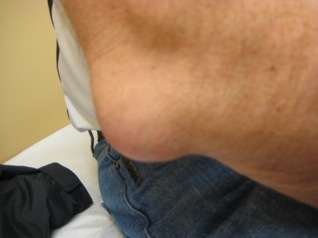The olecranon bursa is a sac between the tip of the elbow bone and the overlying skin; it allows skin to move well over the bone. Olecranon “bursitis” is inflammation of the bursa. This can result from a direct blow (trauma) to the tip of the elbow or from leaning on the tip of the elbow for long periods of time. Medical conditions like gout and rheumatoid arthritis can be associated with olecranon bursitis. An infection also can result if the skin is punctured in that area.

In general, the first symptom is swelling at the tip of the elbow. Considerable swelling can occur even without pain. Motion of the elbow usually is normal unless there is a significant amount of swelling. Redness or warmth of the skin, tenderness of the bursa, or drainage (especially of pus) are warning signs of infection; if any of these are present, evaluation by a doctor as soon as possible is recommended.

A doctor usually will examine the elbow. X-rays might be taken; often, a “bone spur” or a “foreign body” (an object like pieces of gravel that should not be there) are found in patients with olecranon bursitis.
Most olecranon bursitis can be treated without surgery. Unless there are signs of infection, it is reasonable to “observe” this while avoiding leaning on the elbow. Ice and elevation can be helpful, as can an elbow pad. Symptoms often resolve. In some cases, the doctor might recommend removing fluid and injecting steroid into the bursa.
Infected olecranon bursitis usually is drained to help get rid of the infection and to see what bacteria is causing the infection in order to choose which antibiotic will be effective.
Surgery might be recommended if either an infected or non-infected bursitis doesn’t resolve without it.